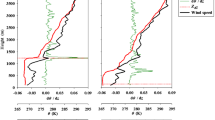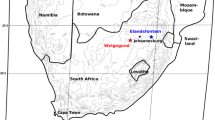Abstract
Since 2006 different remote monitoring methods for determining mixing-layer height have been operated in parallel in Augsburg (Germany). One method is based on the operation of eye-safe commercial mini-lidar systems (ceilometers). The optical backscatter intensities recorded with ceilometers provide information about the range-dependent aerosol concentration; gradient minima within this profile mark the tops of mixed layers. Special software for these ceilometers provides routine retrievals of lower atmospheric layering. A second method, based on sodar observations, detects the height of a turbulent layer characterized by high acoustic backscatter intensities due to thermal fluctuations and a high variance of the vertical velocity component. This information is extended by measurements with a radio-acoustic sounding system (RASS) that directly provides the vertical temperature profile from the detection of acoustic signal propagation and thus temperature inversions that mark atmospheric layers. Ceilometer backscatter information is evaluated by comparison with parallel measurements. Data are presented from 2 years of combined ceilometer and RASS measurements at the same site and from comparison with a nearby (60 km) radiosonde for larger-scale humidity information. This evaluation is designed to ensure mixing-layer height monitoring from ceilometer data more reliable.
Similar content being viewed by others
References
Angelini F, Barnaba F, Landi TC, Caporaso L, Gobbi GP (2009) Study of atmospheric aerosols and mixing layer by lidar. Radiat Prot Dosim. doi:10.1093/rpd/ncp219
Angevine WM, Ecklund WL (1994) Errors in radio acoustic sounding of temperature. J Atmos Ocean Technol 11: 837–848
Angevine WM, Bakwin PS, Davis PJ (1998) Wind profiler and RASS measurements compared with measurements from a 450-m-tall tower. J Atmos Ocean Technol 15: 818–825
Banta RM, Olivier LD, Levinson DH (1993) Evolution of the Monteray bay sea-breeze layer as observed by pulsed Doppler lidar. J Atmos Sci 50: 3959–3982
Beyrich F (1997) Mixing height estimation from sodar data—a critical discussion. Atmos Environ 31: 3941–3953
Brunekreef B, Holgate ST (2002) Air pollution and health. Lancet 360: 1233–1242
Dorling SR, Davies TD, Pierce CE (1992) Cluster analysis: a technique for estimating the synoptic meteorological controls on air and precipitation chemistry—results from Eskdalemuir, South Scotland. Atmos Environ 26: 2583–2602
Emeis S (2010) Measurement methods in atmospheric sciences. In situ and remote. Series: quantifying the environment, Vol.1. Borntraeger, Stuttgart, p xiv+257
Emeis S (2011) Surface-based remote sensing of the atmospheric boundary layer. Series: atmospheric and oceanographic sciences library, vol.40. Springer, Dordrecht, p x+200
Emeis S, Schäfer K (2006) Remote sensing methods to investigate boundary-layer structures relevant to air pollution in cities. Boundary-Layer Meteorol 121: 377–385
Emeis S, Türk M (2004) Frequency distributions of the mixing height over an urban area from sodar data. Meteorol Z 13: 361–367
Emeis S, Münkel C, Vogt S, Müller W, Schäfer K (2004) Determination of mixing-layer height. Atmos Environ 38: 273–286
Emeis S, Jahn C, Münkel C, Münsterer C, Schäfer K (2007) Multiple atmospheric layering and mixing-layer height in the Inn valley observed by remote sensing. Meteorol Z 16: 415–424
Emeis S, Schäfer K, Münkel C (2008) Surface-based remote sending of the mixing-layer height—a review. Meteorol Z 17: 621–630
Emeis S, Schäfer K, Münkel C (2009) Observation of the structure of the urban boundary layer with different ceilometers and validation by RASS data. Meteorol Z 18: 149–154
Engelbart DAM, Bange J (2002) Determination of boundary-layer parameters using wind profiler/RASS and sodar/RASS in the frame of the LITFASS project. Theor Appl Climatol 73: 53–65
Feltz WF, Howell HB, Knuteson RO, Woolf HM, Revercomb HE (2003) Near continuous profiling of temperature, moisture, and atmospheric stability using the atmospheric emitted radiance interferometer (AERI). J Appl Meteorol 42: 584–597
Güldner J, Spänkuch D (2001) Remote sensing of the thermodynamic state of the atmospheric boundary layer by ground-based microwave radiometry. J Atmos Oceanic Technol 18: 925–933
Hennemuth B, Lammert A (2006) Determination of the atmospheric boundary layer height from radiosonde and lidar backscatter. Boundary-Layer Meteorol 120: 181–200
Martin L, Schneebeli M, Mätzler C (2006) Tropospheric water and temperature retrieval for ASMUWARA. Meteorol Z 15: 37–44
Matthias V, Bösenberg J (2002) Aerosol climatology for the planetary boundary layer derived from regular lidar measurements. Atmos Res 63: 221–245
Menut L, Flamant C, Pelon J, Flamant PH (1999) Urban boundary-layer height determination from lidar measurements over the Paris area. Appl Opt 38: 945–954
Münkel C (2007) Mixing height determination with lidar ceilometers—results from Helsinki Testbed. Meteorol Z 16: 451–459
Sarwar G, Pinder RW, Appel KW, Mathur R, Carlton AG (2009) Examination of the impact of photoexcited NO2 chemistry on regional air quality. Atmos Environ 43: 6383–6387
Schäfer K, Emeis S, Hoffmann H, Jahn C (2006) Influence of mixing layer height upon air pollution in urban and sub-urban areas. Meteorol Z 15: 647–658
Schäfer K, Vergeiner J, Emeis S, Wittig J, Hoffmann H, Obleitner F, Suppan P (2008) Atmospheric influences and local variability of air pollution close to a motorway in an Alpine valley during winter. Meteorol Z 17: 297–309
Schäfer K, Helmis C, Emeis S, Sgouros G, Kurtenbach R, Wiesen P, Münkel C, Jahn C, Hoffmann M, Anamaterou E, O’Connor M (2010) Application of continuous remote sensing of mixing layer height for assessment of airport air quality. In: Picard RH, Schäfer K, Comeron AT (eds) Remote sensing of clouds and the atmosphere XV. Proceedings of SPIE, vol 7827. SPIE, Bellingham, WA, USA, pp 782706-1–782706-12. doi:10.1117/12.865101
Skakalova TS, Savov PB, Grigorov IV, Kolev IN (2003) Lidar observation of breeze structure during the transition periods at the southern Bulgarian Black sea coast. Atmos Environ 37: 299–311
Smith WL, Feltz WF, Knuteson RO, Revercomb RE, Woolf HM, Howell HB (1999) The retrieval of planetary boundary layer structure using ground-based infrared spectral radiance measurements. J Atmos Oceanic Technol 16: 323–333
Song Y, Zhang M, Cai X (2006) PM10 modeling of Beijing in the winter. Atmos Environ 40: 4126–4136
van Pul WAJ, Holtslag AAM, Swart DPJ (1994) A comparison of ABL heights inferred routinely from lidar and radiosondes at noontime. Boundary-Layer Meteorol 68: 173–191
Weitkamp, C (ed) (2005) Lidar range-resolved optical remote sensing of the atmosphere. Springer Science + Business Media Inc, New York, p 455
Author information
Authors and Affiliations
Corresponding author
Rights and permissions
About this article
Cite this article
Emeis, S., Schäfer, K., Münkel, C. et al. Evaluation of the Interpretation of Ceilometer Data with RASS and Radiosonde Data. Boundary-Layer Meteorol 143, 25–35 (2012). https://doi.org/10.1007/s10546-011-9604-6
Received:
Accepted:
Published:
Issue Date:
DOI: https://doi.org/10.1007/s10546-011-9604-6




